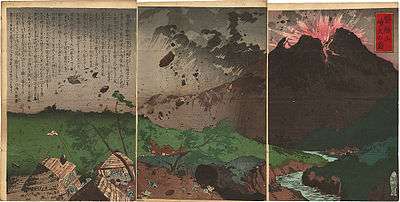1888 eruption of Mount Bandai
The 1888 eruption of Mount Bandai was a major volcanic eruption which occurred during the Meiji period of the Empire of Japan. The eruption occurred on July 15, 1888, and pyroclastic flows buried villages on the northern foot of the mountain, and devastated the eastern part of Bandai region, Fukushima Prefecture north of Tokyo.[1] At least 477 people were killed and hundreds more were injured and rendered homeless in what became the worst volcanic disaster in recent Japanese history.[2]
| 1888 eruption of Mount Bandai | |
|---|---|
 Ukiyo-e print by Tankei depicting the 1888 eruption of Mount Bandai | |
| Volcano | Mount Bandai |
| Start date | July 15, 1888 |
| End date | July 15, 1888 |
| Type | Explosive eruption |
| Location | Honshu, Empire of Japan 37°36′46″N 140°04′34″E |
| VEI | 4 |
Background
Mount Bandai is a stratovolcano. Its last eruption had occurred in 806. Mount Bandai had a conical profile, and had been compared in literature with Mount Fuji. The Bandai volcano consisted of four peaks: O-bandai (1,819 meters), Kushigamine (1,636 meters), Akahaniyama (1,427 meters), and Ko-bandai which was slightly lower than that of O-bandai.
Small earthquakes were reported on July 8, 9, and 10. Moderate earthquakes occurred on July 13 and 14. However, as earthquakes are commonplace all over Japan, these tremors were not viewed by the local populace with undue concern.
Eruption
On July 15, three earthquakes occurred prior to the main eruption. The third one was the largest, at around magnitude 5. At 07:45, while the ground was still heaving, a Phreatic eruption began at the fumaroles approximately 100 meters upslope from the Kaminoyu hot spring resort on the flank of Ko-Bandai. Successive explosions occurred 15 to 20 times per minute. Each explosion was accompanied by thunder and a black eruption column ascending to a height of 1300 meters. The last explosion was observed to discharge a horizontal cloud, mainly toward the north.
Within 10 minutes after the explosions, a pyroclastic flow swept over the eastern part of the volcano. According to eyewitness, phreatic eruptions continued after the large collapse at least twice. At around 10:00, hot rain started falling, transforming the vast quantity of volcanic ash into lahar (volcanic mudslides). At 16:00, ash fall ceased.
Aftermath
The eruption had transformed hundreds of square kilometers of forest and farmland around the mountain into a wasteland. Several villages were completely buried under landslides, which also considerably altered the topography of the region by diverting rivers and creating a number of new lakes. Approximately 1.5 cubic kilometers of the summit of the mountain had collapsed, and flowed northwards.
Japanese geologists Seikei Sekiya and Y. Kikuchi from the Imperial University of Tokyo visited Bandai within days of the eruption. After spending several months studying the new crater and the devastated areas, they published a report in English (“The eruption of Bandai-san” Tokyo Imperial University College of Sciences Journal 3 (1890), pp 91–171), which is considered a classic in volcanology. A photograph of the ruined mountain was the first news photograph printed by the Yomiuri Shimbun in Japan.[3]
The eruption was the first major disaster faced by the fledgling Japanese Red Cross, which moved in quickly to provide disaster relief.
The lake district formed by this cataclysm is now known as Urabandai or Bandai-kōgen, and has become a popular tourist destination, especially the multi-hued lakes of Goshiki-numa.
References
- Česky. "Bandai Volcano, Honshu (Japan) - facts & information / VolcanoDiscovery:". Volcanodiscovery.com. Retrieved 2016-01-31.
- Smith, Encyclopedia of Geology, pp 461
- Clancey, Earthquake Nation, pp 104
Further reading
- Clancey, Gregory (2006). Earthquake Nation: The Cultural Politics of Japanese Seismicity, 1868-1930. University of California Press: University of California Press. ISBN 0-520-24607-1.
- Smith, Roger (2000). Encyclopedia of Geology. Routledge. ISBN 1-57958-188-9.
External links
- Photographs of the eruption and aftermath at University of Berkeley (membership required to view full images)
- United States Geological Survey report
- New York Times September 7, 1888